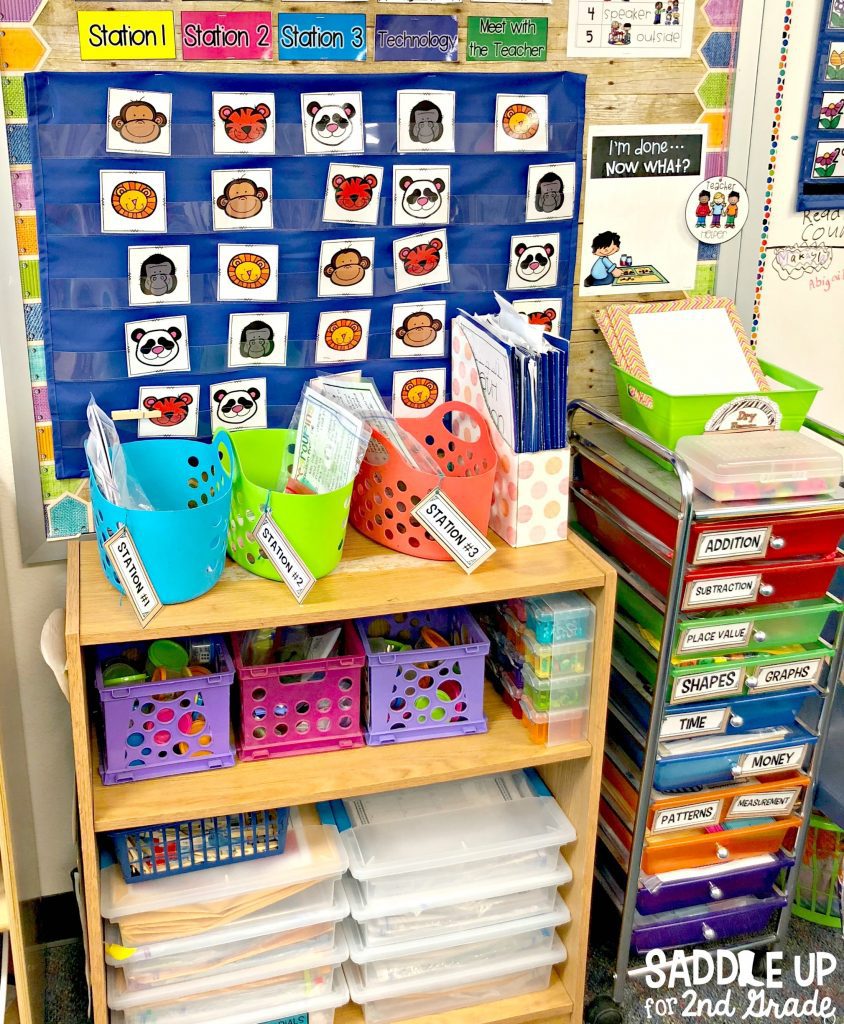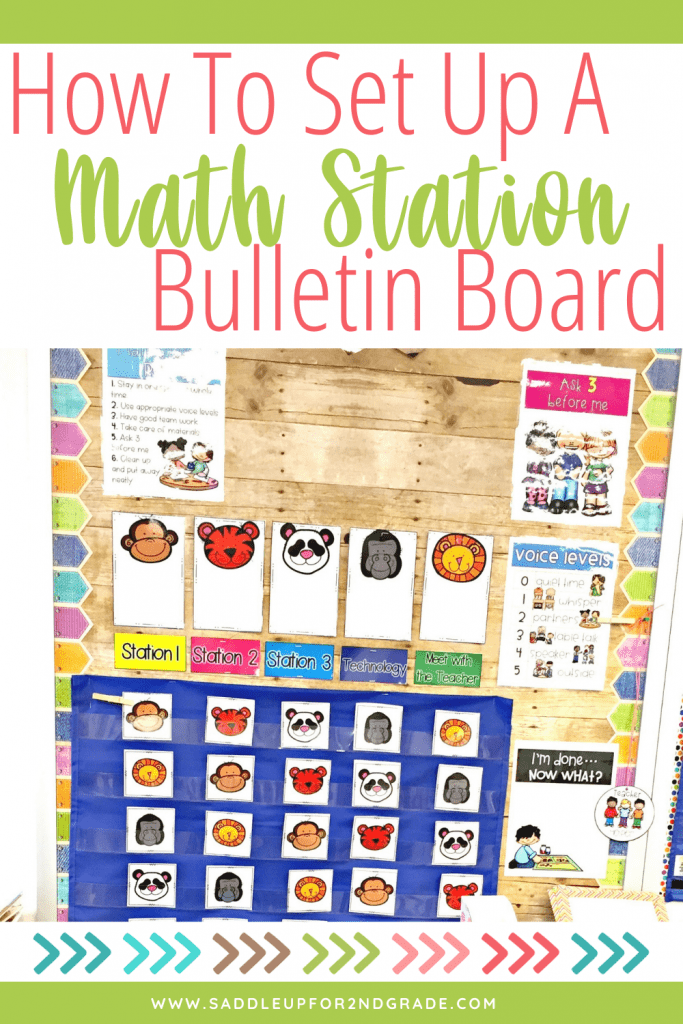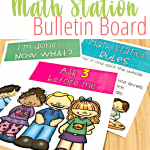

Join me for a FREE, Guided Math workshop to discover how to easily incorporate Guided Math into your current schedule!
You might be a teacher if you love a good, decorated bulletin board. You might also be a teacher if you want your bulletin boards to serve a purpose in your classroom. Read on to learn how to set up a guided math bulletin board to help your students thrive during math stations.
This post contains affiliate links. You can see my disclosure here.

A math station bulletin board is a bulletin board in your classroom that serves as a centralized hub for all of your math station group information, activities, tools, and rules.
This math bulletin board helps students find everything they need to be successful during math stations with ease.
This helps cut down on wasted time, interruptions, and students running all over the classroom looking for what they need. The best part about a math station bulletin board is that you can create it once and keep it up for years to come!
The first component of a math station bulletin board is the rotation board. The math station labels at the top of the pocket chart show which math station each small group is at. It also shows students where they’ll be going next.
I like to put my rotation board in a large pocket chart. This keeps it simple, organized, and easy to rotate groups.
Since your math small groups are always changing, keeping the rotation board in a pocket chart makes it flexible and easy to change out groups and move them to different stations as needed.
Each small group has an animal picture so students know which group they belong to. I like using animals to make it fun, but you can also use colors, numbers, or another theme.
In my Editable Math Station Rotation Board resource, you’ll find 3 different theme options. It also comes in digital and printable versions.
Above the math station labels are a set of blank animal posters. You can use these blank posters in a variety of ways, based on your personal preference and student needs.
You can use these posters to write student names or numbers. This allows each student (and you) to easily see who is in each group. This is helpful especially since your small groups are constantly changing at the beginning of each new math unit or concept.
You can also use these posters to write the title of the activity they’ll be doing at each station. That way, students know exactly what to look for.
As shown in the picture, the first card in the pocket chart, the Monkey card, has a clothespin attached to it. This shows that for the first round of math stations, the Monkey group will be going to station 1.
Following that row to the right, the Tigers will be at station 2, the Pandas at station 3, Gorillas at technology, and the Lions will be at the teacher table.
When it is time to rotate, one student will move the clothespin one row down to show the next rotation of stations. This can be a student helper. You can even make this a classroom job for the week.
After the clothespin reaches the bottom of the chart and each group has made it to each math station, the clothespin goes back to the top. This starts another round.
The next component of a math station bulletin board is the math station rules posters. It is important to spend time introducing and practicing these rules at the beginning of the year as students are learning and implementing the procedures for math stations.
However, you must continue to practice these rules and reinforce them constantly throughout the year. This will be a game-changer for your classroom management and the flow of your math stations.
By keeping your math station rules on display all year long, students will always have that reminder and reinforcement of what positive choices and on task behavior looks like during math stations.
One of my math station posters is the “Ask 3 Before Me” poster. I’m sure you’ve had your small group time interrupted a time or two by a student who didn’t know what to do at their math station.
That can be so frustrating to you as the teacher. It is also frustrating to the students at your teacher table who are craving your undivided attention.
The “Ask 3 Before Me” poster helps minimize interruptions at the small group table by giving students another way to get help. I like to choose 3 students who I know can answer any question or help other students effectively. This can be a different 3 students each day, week, or math unit.
If a student is stuck, doesn’t know how to complete an activity, or has any kind of question during math stations, they must ask those 3 students for help before interrupting the teacher at the small group table.
This cuts down on interruptions and allows the teacher to stay focused on their small group table students. It also gives those 3 students the opportunity to be leaders. They can use their knowledge to help explain concepts or directions to other students.
The voice level chart is another effective classroom management poster that I like to include on my math bulletin board. This is a great visual to show students which voice level we are currently using during our math block.
You can use a clothespin to clip the voice level students should be using. This might be whispering, using partner voices, table voices, etc.
This is another effective classroom management strategy that students will learn at the beginning of the school year and work on all year long.
By reinforcing these expectations, you can ensure that your math stations run more smoothly and are more effective.
Another common teacher struggle is when you’re working with students at the small group table and a student comes up to you saying, “Teacher! I’m done… now what?”
In order to prevent this interruption from happening, you can set your early finishers up for success with an “I’m done… now what?” poster. I like to laminate mine or stick it in a plastic, dry-erase sleeve so I can write on it with dry-erase marker.
Depending on the concept or skill being focused on, write an activity for students to complete when they are finished with their work. That way, once they are finished and have double-checked their work, they can go to the poster and see what their next activity is.
Your early finisher activities do not have to be complicated or elaborate. They just have to be something that all students can work on independently.
A few great options are:
You can grab my math stations rules poster, “Ask 3 Before Me” poster, and “I’m done… now what?” poster in my Guided Math Posters Freebie.
Also included in my math station bulletin board area are my labeled math station baskets and drawers. This is where I store all of the different math station activities and supplies. To learn more about how I organize my math station supplies in this area, check out my math station organization blog post.

I hope this breakdown of my math station bulletin board has helped you see how effective it can be in keeping your students organized and on task during math stations.
For more information on how to implement math stations that run themselves in your classroom, check out this blog post.
For a step-by-step video tour of my math bulletin board, be sure to check out my YouTube video below.
Pin the image below to come back to this post at any time!

Math should be fun, not stressful. Ditch the timed math fact tests and replace them with math games that will help your students learn and retain information more effectively.
© Saddle Up for 2nd Grade • Website by KristenDoyle.co
